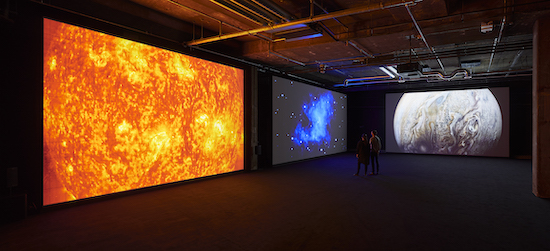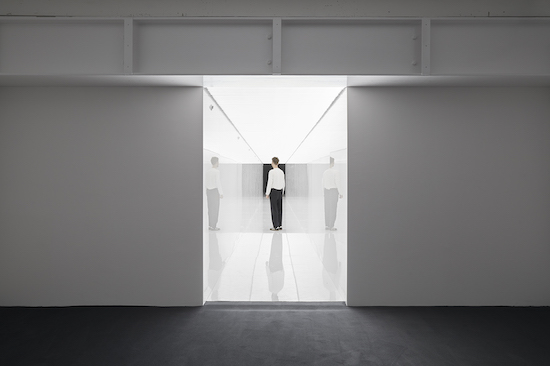all photos, credit: Jack Hems
In a recent Guardian interview, the artist Ryoji Ikeda describes himself as a freshly converted anti-humanist. For a figure whose work can be both dazzling and inscrutable, this admission feels somehow revelatory. Working across electronic music, live performance, and audiovisual installations, it’s for the latter that Ikeda has become best known over the last decade. Projects such as his test pattern series take huge data sets – drawn from existing images, sounds, texts – and, converting them into 0s and 1s, generate swarms of flashing monochrome light and synthesised sound. I had never really thought there was much to it, but what if anti-humanism gives sense to these abstract spectacles? Does Ikeda want us to worship the power of sound and light to dominate us – to crystallise our smallness in the grand scheme of things? If he does, can that really end up anywhere except distraction or nihilism?
His current exhibition in London, the largest yet held anywhere in the world, offers plenty of scope for thinking through these questions. It’s the latest in a series of linkups between Ikeda and The Vinyl Factory, stretching back to the UK premiere of his supersymmetry in 2015 and held, like its antecedents, at 180 The Strand. That space, which has hosted standout group exhibitions like Strange Days: Memories of the Future (2018) and Infinite Mix (2016), is surely among London’s most exciting, with a protean rawness that lends itself to spatial provocation. This time the venue’s basement is the setting, decorated in eerie, spartan grayscale. Snaking through a series of chambers, the show brings together ten installations spanning sculpture, projection, screen and sound. Together these draw on more than a decade of activity, from earlier LED pieces like line and spectra III (2008/19) to the recent audiovisual spectacle data-verse.
Some works serve as passageways: spectra III, for example, floods an oppressively small corridor with pale light, like a kind of retina-cleanser for what’s to come. In one room, large and cooly lit, a set of six hulking loudspeakers emit a cluster of tones. Somebody’s child is sprawled on the floor, their head swivelling back and forth to appreciate the phasing effect. Dad takes a photo. The work is A [continuum], in which dozens of versions of the note ‘A’ – corresponding to different instruments, institutions and historical periods – commingle and evaporate over time, their mutual interference hanging almost solidly in space.
There’s an interesting point implicit here, about the social construction of musical pitch, but it’s curiously lost in Ikeda’s sonic materialism. This would be fine if its obsessions hadn’t been exhausted decades ago by figures like La Monte Young and Eliane Radigue. As if to compound the emptiness of the work, every reference to it in the press materials foregrounds not its possible intentions but its technical prowess, deploying “six colossal Meyer SB-1 speakers”. Phwoar. A similar problem afflicts test pattern, in which strips of white light are projected directly down onto a black carpet, flashing and sliding stroboscopically across the carpet. However mesmerising, it’s surely just a fussier re-hash of Tony Conrad’s The Flicker (1966), which uses the simpler method of a single white frame flashing at varying speeds to produce hallucinatory effects. If it felt radical, in the mid-1960s, to see art as a means for exploring the thresholds of human perception, to rehearse these experiments in 2021 is oddly asocial.

Perhaps the idea is that we understand these pieces in terms of Ikeda’s overarching concern with data. In A [continuum], data is harvested as source material; in others, like data.scan (2011) and exp #1 (2020), it is the harvesting itself we seem to be witnessing, with laser-like red lines gliding across space as if scanning for rogue information. Are they friend or foe? Here, at least, the suggestion of an ambivalent kind of monitoring points to timely questions about our own relationships with surveillance technology.
But it’s the multi-screen installation data-verse 1-3 which thematises data most explicitly. Images of topography and neural networks collide with and surge against others of weather systems and molecular structures. The sense of entanglement is overwhelming, not least because the screens themselves occupy such an impressive scale. At a certain moment it all drops away to blackness, promptly replaced by a close-up of a burning sun. From a different kind of artist this could be a metaphor – albeit a blunt one – for the consequences of our willingness to glorify big data. But for Ikeda as anti-humanist, it’s probably just another nod to our cosmic insignificance. This feels like data as religion, with Ikeda’s iconography commanding that we simply stare in awe. But the exhilaration, as with most art that scrupulously shuts out the social, is short-lived.
Ryoji Ikeda is at 180 The Strand until 1 August


